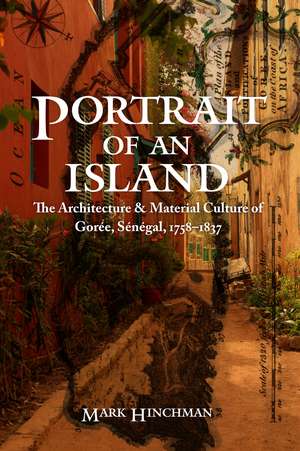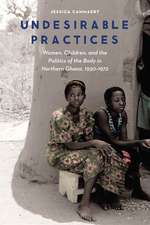Portrait of an Island: The Architecture and Material Culture of Gorée, Sénégal, 1758–1837: Early Modern Cultural Studies
Autor Mark Hinchmanen Limba Engleză Hardback – 30 noi 2015
The once-famous trading center of Gorée, Sénégal, today lies in the busy harbor of the modern city of Dakar. From its beginnings as a modest outpost, Gorée became one of the intersections linking African trading routes to the European Atlantic trade. Then as now, people of many nationalities poured into the island: Dutch, English, French, Portuguese, Tukulor, and Wolof. Trading parties brought with them gold, firewood, mirrors, books, and more. They built houses of various forms, using American lumber, French roof tiles, freshly cut straw, and pulverized seashells, and furnished them in a fashion as cosmopolitan as the city itself.
A work of architectural history, Portrait of an Island explores the material culture and social relations of West Africa in the eighteenth and nineteenth centuries. Multiple features of eighteenth-century Gorée—its demographic diversity; the prominence of women leaders; the phenomenon of identities in flux; and the importance of fashion and international trade—articulate its place in the construction of an early global modernity. An examination of the built and natural landscape, Portrait of an Island deciphers the material culture involved in the ever-changing relationships among male, female, rich, poor, free, and slave.
A work of architectural history, Portrait of an Island explores the material culture and social relations of West Africa in the eighteenth and nineteenth centuries. Multiple features of eighteenth-century Gorée—its demographic diversity; the prominence of women leaders; the phenomenon of identities in flux; and the importance of fashion and international trade—articulate its place in the construction of an early global modernity. An examination of the built and natural landscape, Portrait of an Island deciphers the material culture involved in the ever-changing relationships among male, female, rich, poor, free, and slave.
Preț: 502.66 lei
Nou
Puncte Express: 754
Preț estimativ în valută:
96.20€ • 100.06$ • 79.42£
96.20€ • 100.06$ • 79.42£
Carte tipărită la comandă
Livrare economică 14-28 aprilie
Preluare comenzi: 021 569.72.76
Specificații
ISBN-13: 9780803254138
ISBN-10: 080325413X
Pagini: 420
Ilustrații: 78 illustrations, 3 tables
Dimensiuni: 152 x 229 x 35 mm
Greutate: 0.77 kg
Editura: Nebraska
Colecția University of Nebraska Press
Seria Early Modern Cultural Studies
Locul publicării:United States
ISBN-10: 080325413X
Pagini: 420
Ilustrații: 78 illustrations, 3 tables
Dimensiuni: 152 x 229 x 35 mm
Greutate: 0.77 kg
Editura: Nebraska
Colecția University of Nebraska Press
Seria Early Modern Cultural Studies
Locul publicării:United States
Notă biografică
Mark Hinchman is an associate professor in the Design School at Taylors University, Malaysia, and a professor in the Interior Design Program at the University of Nebraska–Lincoln. He is the author of History of Furniture: A Global View and The Fairchild Dictionary of Interior Design.
Cuprins
List of Illustrations
Acknowledgments
Introduction: An Interdisciplinary Stroll in Early Modern West Africa
1. The Natural Landscape: The Island and Cartography
2. The Built Landscape: Architecture and Urbanism
3. The Elite: Patrons, Critics, and Fans
4. The Middle: Occupational Groups
5. The Bottom Rung: Servants and Slaves
6. Things: Houses and Their Contents
Conclusion: Building Memories
Appendix of Tables
Notes
Bibliography
Index
Recenzii
"A very convincing portrait."—Michelle Moore Apotsos, CCA Reviews
"A well-researched, well-documented, and well-argued piece of scholarship. . . . Hinchman makes an important contribution to the literature on the history of art and architecture, the history of the built environment, and slavery and the slave trade in West Africa, in general, and in Senegal, in particular."—Kalala Ngalamulume, H-France
"Portrait of an Island is a valuable asset for scholars as well as for students of African colonial architecture, the material cultures of imperialism, and early modern histories of identity formation and cultural exchange."—Dwight Carey, Journal of the Society of Architectural Historians
“A major contribution to the understanding of early modern building traditions and lifestyles in West Africa, a literature that is missing in the larger architectural body of work.”—Nnamdi Elleh, author of African Architecture: Evolution and Transformation































